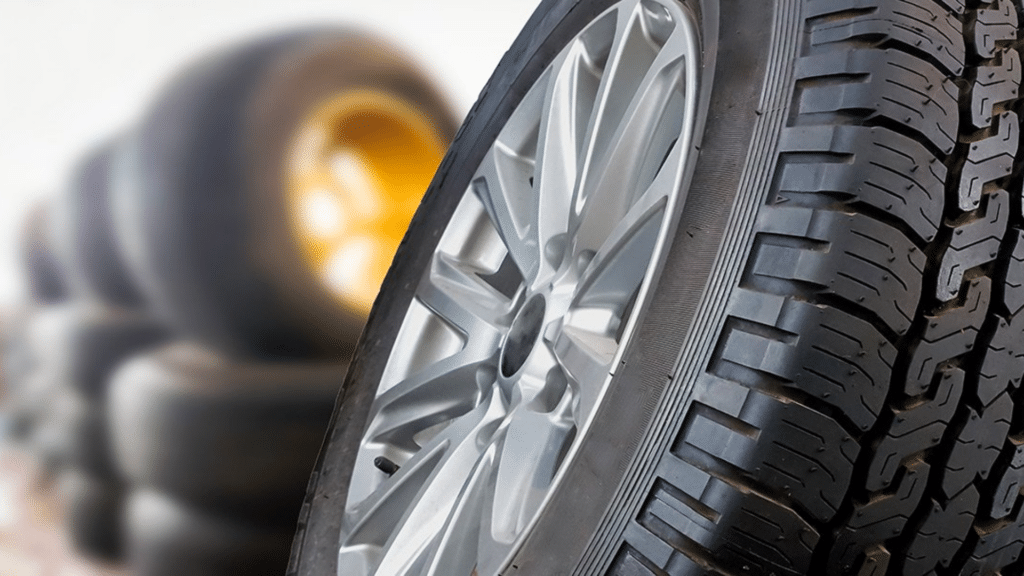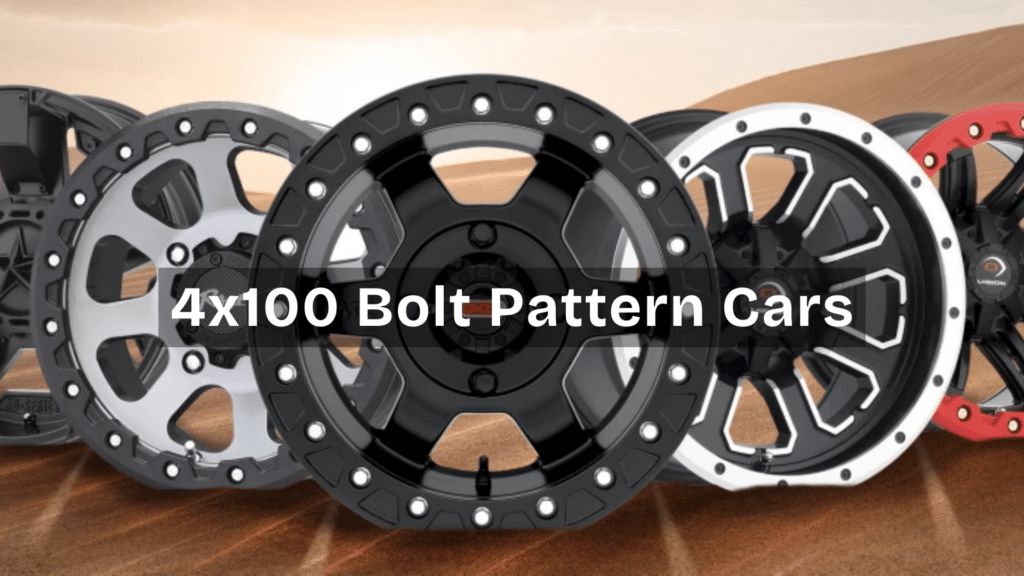If you’re looking for wheels with a 4×100 bolt pattern, it’s important to know which cars use it. The 4×100 bolt pattern means the wheel has four lug nuts, spaced 100 millimeters apart in a circular pattern.
This is a common size for smaller cars, hatchbacks, and older models from brands like Honda, Toyota, BMW, and Volkswagen.
Getting the right bolt pattern is important because the wheels won’t fit properly if it doesn’t match. Even if they look similar, a different pattern can cause wobbling, uneven tire wear, or unsafe driving conditions.
In this blog, I’ll go over which cars have a 4×100 bolt pattern, how to check if your car uses it, and what to consider before buying new wheels. If you’re upgrading or replacing wheels, knowing your car’s bolt pattern will help you make the right choice!
Understanding the 4×100 Bolt Pattern & Its Measurements

If you’re shopping for new wheels, you may have come across the 4×100 bolt pattern. But what does it mean? Simply put, it describes how the lug nuts are arranged on a wheel.
- The “4” means the wheel has four lug nuts.
- The “100” means the lug nuts are 100 millimeters apart in a circular pattern.
This bolt pattern is common on compact cars, hatchbacks, and older models, including cars from Honda, Toyota, Volkswagen, and BMW.
How to Measure a 4×100 Bolt Pattern
If you’re unsure whether your car has a 4×100 bolt pattern, you can measure it yourself:
- Count the Lug Nuts – You should have four.
- Measure the Bolt Circle – Start from the center of one lug nut and measure to the center of the lug nut directly across from it.
- Check the Measurement – If it’s 100mm, you have a 4×100 bolt pattern.
If your wheels don’t match the bolt pattern, they won’t fit properly, leading to wobbling, handling issues, or unsafe driving conditions. Always double-check the bolt pattern before buying new wheels.
Why the Right Bolt Pattern Matters
Choosing the correct bolt pattern is important for safety and performance. If your wheels don’t match the bolt pattern, they won’t fit properly, no matter their size.
Even if the wheels seem to bolt on, a slight difference in the pattern can cause wobbling, poor alignment, and uneven tire wear.
Using the wrong wheels can also stress your suspension and wheel bearings, leading to long-term damage. This can affect steering stability and handling, making driving unsafe.
Before buying new wheels, always double-check your bolt pattern to ensure a perfect fit. If you are unsure, check your car’s owner’s manual or consult a trusted mechanic to avoid mistakes.
Vehicles Using the 5×100 Bolt Pattern
The 4×100 bolt pattern is common on compact cars, hatchbacks, and small sedans. It means the wheel has four lug nuts, spaced 100mm apart in a circular pattern. If you’re looking for wheels with this bolt pattern, here are some of the most popular vehicles that use it.
1. Honda & Acura: Honda Civic (1984–2000), Honda Fit (2001–2020), Honda CRX (1984–1991) and Acura Integra (1986–2001).
2. Toyota & Scion: Toyota Corolla (1983–2002), Toyota Yaris (1999–2020), Toyota MR2 (1985–1999) and Scion xA / xB (2004–2006).
3. Volkswagen & BMW: Volkswagen Golf / GTI (1975–1998), Volkswagen Jetta (1980–1998), BMW E30 3 Series (1982–1991) and BMW Z3 (1995–2002).
4. Mazda & Nissan: Mazda Miata (1989–2005), Nissan Micra (1992–2019) and Nissan Sentra (1982–1999).
Before buying wheels, always double-check your car’s bolt pattern to ensure a perfect fit. Depending on the year or trim level, some models may have different bolt patterns. If you’re unsure, check your owner’s manual or ask a mechanic.
Choosing Wheels for a 4×100 Bolt Pattern
If your car has a 4×100 bolt pattern, you need to make sure any new wheels you buy match this pattern exactly. Here’s what to check before buying new wheels.
1. Confirm Your Bolt Pattern
The 4×100 bolt pattern means the wheel has four lug nuts, spaced 100mm apart in a circle. This pattern is common on cars like the Honda Civic, Toyota Yaris, Mazda Miata, and BMW E30. Always check your owner’s manual or measure the bolt pattern to be sure.
2. Pick the Right Wheel Size
Different cars use different wheel sizes. Here’s a simple guide:
- 14- to 15-inch wheels: Best for fuel efficiency and a smooth ride.
- 16- to 17-inch wheels: Good balance between style and performance.
- 18-inch or larger wheels: Sporty look but may affect comfort.
3. Check the Offset
Offset determines how far the wheel sits in or out from the fender. For most cars with a 4×100 bolt pattern, a +35 to +45 offset works best.
- Too much positive offset: The wheels sit too far inside and can hit the suspension.
- Too much negative offset: The wheels stick out too much and may rub against the fender.
4. Match the Hub Bore Size
The hub bore is the hole in the center of the wheel. It must fit your car’s hub for a snug fit. If it’s too big, you may need hub-centric rings to prevent vibrations. If it’s too small, the wheels won’t fit at all.
5. Use the Right Lug Nuts
Some aftermarket wheels require special lug nuts. Using the wrong ones can lead to loose wheels or stripped threads, which can be dangerous. Always check if your new wheels need conical, flat, or spline lug nuts.
Choosing the right wheels for your 4×100 bolt pattern means checking the bolt pattern, size, offset, hub bore, and lug nuts before buying. Taking the time to get the perfect fit will keep your car safe and smooth.
How to Install Wheels on a Car with a 4×100 Bolt Pattern
Installing new wheels on a car with a 4×100 bolt pattern is simple if you follow the right steps. Doing it correctly ensures a safe and smooth ride while preventing damage to your car. Here’s a step-by-step guide to help you.
Step 1: Gather Your Tools
Before you start, make sure you have:
- A jack and jack stands to lift the car safely
- A lug wrench or impact wrench to remove and tighten lug nuts
- A torque wrench to ensure proper tightness
- A wheel alignment tool (optional)
Step 2: Lift the Car and Remove Old Wheels
- Park on a flat surface and engage the parking brake.
- Use the jack to lift one wheel off the ground, and place the jack stands under the car for safety.
- Loosen the lug nuts with a wrench before fully lifting the wheel.
- Remove the lug nuts completely and take off the old wheel.
Step 3: Check the Fit of the New Wheels
Before installing, make sure the new wheels match:
- Bolt Pattern: It must be 4×100 to fit properly.
- Offset and Backspacing: Prevents rubbing or poor handling.
- Hub Bore Size: The center hole must match the hub or use hub-centric rings.
Step 4: Install the New Wheels
- Line up the bolt holes on the wheel with the lug studs on the car.
- Place the wheel onto the hub carefully.
- Hand-tighten the lug nuts in a star pattern (tightening one, then moving to the one across from it) to keep the wheel even.
Step 5: Torque the Lug Nuts Properly
- Lower the car slightly so the wheel touches the ground but doesn’t hold full weight.
- Use a torque wrench to tighten the lug nuts to the correct torque specification (usually between 80-100 ft-lbs for most cars, but check your manual).
- Re-tighten it in a star pattern to keep pressure on the wheel even.
Installing wheels on a 4×100 bolt pattern car is easy if you follow the correct steps. Always double-check fitment, torque the lug nuts properly, and recheck after driving to keep your car safe and running smoothly.
Benefits of the 4×100 Bolt Pattern
The 4×100 bolt pattern is widely used in compact cars, hatchbacks, and small sedans. It means the wheel has four lug nuts, spaced 100mm apart in a circular pattern. But why is this bolt pattern so popular? Here are the key benefits.
1. Wide Availability of Wheels: Since many cars use the 4×100 bolt pattern, there are plenty of OEM and aftermarket wheel options, making it easy to find a style you like.
2. Lightweight and Efficient: Compared to larger bolt patterns, 4-lug wheels are lighter, which can help with fuel efficiency and acceleration. This makes them a great choice for smaller cars that prioritize efficiency.
3. Simple Installation and Maintenance: Wheels with a 4×100 bolt pattern are generally easier to install and require fewer lug nuts to secure, making maintenance quicker and more convenient.
5. Ideal for City and Daily Driving: Many economy cars use this bolt pattern because 4-lug wheels provide enough strength for everyday driving while keeping the car light and nimble.
6. Interchangeability Between Brands: Because so many cars share the 4×100 bolt pattern, wheels from brands like Honda, Toyota, Volkswagen, Mazda, and BMW can sometimes be swapped, as long as the offset and hub bore match.
The 4×100 bolt pattern is a practical choice for daily drivers and enthusiasts alike. It offers plenty of wheel options, easy maintenance, and a lightweight design, making it one of the most versatile bolt patterns.
Common Mistakes to Avoid When Choosing 4×100 Wheels
If your car uses a 4×100 bolt pattern, getting the right wheels is important for safety, performance, and a smooth ride. Many people make simple mistakes when buying or installing wheels, leading to poor fitment, handling issues, or even damage. Here are the most common mistakes to avoid.
1. Not Checking the Bolt Pattern: Just because a wheel looks like it fits doesn’t mean it will. If you try to install wheels with a different pattern, they won’t bolt on properly.
2. Choosing the Wrong Wheel Size: Bigger wheels may look cool, but they can affect handling, gas mileage, and ride comfort.
3. Ignoring Offset and Backspacing: Too much positive offset makes the wheels sit too far inside and may hit the suspension. Too much negative offset makes the wheels stick out too much and may rub against the fenders.
4. Forgetting About Hub Bore Size: The hub bore is the hole in the center of the wheel. The wheel won’t fit on your hub if it’s too small. If it’s too big, you may need hub-centric rings to prevent vibrations while driving.
5. Using the Wrong Lug Nuts: Not all wheels use the same lug nut style. Some require conical, flat, or spline lug nuts. Using the wrong ones can cause loose wheels, stripped threads, or unsafe driving conditions.
6. Not Checking Tire Compatibility: If your tires are too big or small, you may have rubbing issues or incorrect speedometer readings.
7. Not Tightening Lug Nuts Correctly: Lug nuts should always be tightened in a star pattern for even pressure. If they are too loose, the wheels could wobble or come off.
Avoiding these mistakes will help you choose the right wheels, prevent installation issues, and keep your car safe.
Conclusion
Choosing the right wheels for a 4×100 bolt pattern is not just about style—it’s about fit, safety, and performance. If the bolt pattern, size, or offset is wrong, the wheels won’t fit properly and could cause wobbling, poor handling, or uneven tire wear.
Before buying new wheels, always double-check your bolt pattern (4×100) and make sure the wheel size, offset, and hub bore are correct for your car.
If you’re changing wheel size, make sure your tires match so your speedometer stays accurate and your ride stays smooth.
A little research now can save you money and prevent mistakes. The right wheels will not only improve your car’s appearance but also keep it safe and comfortable on the road.
Frequently Asked Questions
What size wheels fit a 4×100 bolt pattern?
Most vehicles with a 4×100 bolt pattern use wheels between 14 and 17 inches. Always check your owner’s manual or fitment guide before buying new wheels.
Can I install 4×100 wheels myself?
Yes, but make sure you torque the lug nuts properly, tighten them in a star pattern, and check for vibrations after driving a short distance.
Where can I buy wheels with a 4×100 bolt pattern?
You can find them at Tire Rack, Discount Tire, Fitment Industries, or local wheel shops. Always confirm fitment before purchasing to avoid compatibility issues.
Can I use spacers to fit wheels with a different bolt pattern?
No, spacers only adjust offset and backspacing, not bolt pattern. You’d need adapter plates to fit different patterns, which can affect safety and handling.
Can I put 4×114.3 wheels on a 4×100 car?
No, unless you use bolt pattern adapters, but these can affect safety and handling. It’s always best to use the correct 4×100 bolt pattern wheels.


